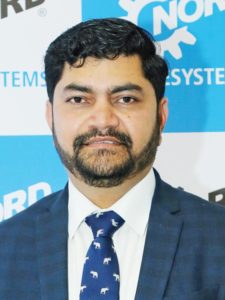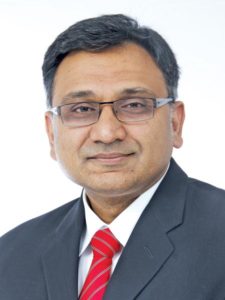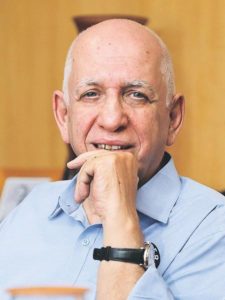Challenged, but optimistic
The Indian construction and infrastructure sector has seen tremendous growth in the last few years even though the Covid pandemic has pulled back the growth momentum temporarily. Increased government spent and the policy support has kept the infrastructure developments in

The Indian construction and infrastructure sector has seen tremendous growth in the last few years even though the Covid pandemic has pulled back the growth momentum temporarily. Increased government spent and the policy support has kept the infrastructure developments in the country at its pace, braving the challenges from the pandemic. The growth momentum in infrastructure has always been a boon to the development of components, accessories and spares market in the country. The new policy initiatives like Atmanirbhar Bharat and incentive schemes like PLI have helped revive the local manufacturing of components, accessories and spares that will make the players competitive in the global market as well as in India. However, speciality products like high precision components are still lagging behind in local manufacturing as these products are largely being imported by equipment manufacturers. More policy support for high-precision manufacturing of such components in India will make the Indian components segment globally competitive and help make the vision of make in India for India and the world a success. Above all, the volume of construction equipment in use at projects also need to grow.
Stakeholders from components share their views on the market trend and what to look for in the coming years for the components, accessories and spares segments.
 Saurabh Kulkarni, B&R Industrial Automation
Saurabh Kulkarni, B&R Industrial Automation
“The world is growing day by day and increasing urbanization, need for connected infrastructure, upgrading brownfield unproductive systems to meet the current requirements are the demand drivers for components and accessories in the construction industry. Additional concerns are human & equipment safety and government regulations on equipment emissions contribute to the industry’s overall statistics. Higher equipment usage in construction activities leads to frequent wear & tear of machine parts, thereby supporting the demand for spares. The spare parts segment is witnessing an upward market trend due to maintenance and restoration activities investments.
Digitalization and advancements in automation systems result in higher performance and reduced maintenance. It is adding up new functions for improved operating efficiency and higher quality than before; today’s construction equipment needs an automation system that is both powerful and scalable.
Construction equipment manufacturers face a challenge implementing intelligent machine functions and quickly maintaining them long-term. In B&R, we continue to open new possibilities for construction equipment manufacturers with our powerful software products, modular control, and I/O systems. These comprehensive standardized components are perfect for implementing flexible automation solutions. To meet the market demands, we develop new products, adopt new strategies, and promote collaborations with our customers to gain traction in the construction equipment market.”
 Kennady V. Kaippally, Bonfiglioli India
Kennady V. Kaippally, Bonfiglioli India
“The primary demand drivers for components, accessories etc. remain the need for new construction equipment. This is driven by many factors including:
- Need for better infrastructure which is enabled by government spending in roads, rails, ports, metros, irrigations projects etc.
- India still has low equipment density compared to global standards, and hence the need to mechanise spurs the demand for new equipment.
- Shift from general purpose equipment to specialised high productivity equipment.
Bonfiglioli with its local engineering centre and a world-class local manufacturing facility is geared up to meet the surge in demand for these products. Over the years, we have consistently and continuously invested in our Indian facility making us the largest producer and the preferred choice of reduction drives for construction equipment in India.”
 Neeraj Bisaria, Premium Transmission
Neeraj Bisaria, Premium Transmission
“As the domestic market scenario is moving back to normal after being severely hit by first and second waves of Covid-19, large scale infrastructure projects are picking up pace. This revival has an optimistic effect on the industry. Threat of the pandemic and multiple incoming Covid variants are slowing down the decision making at stages but it is concurrently strengthening the necessity of localisation.
India, being a developing nation, it is a well-known fact that our development is hugely propelled by the infrastructure sector. Majority of the projected investments of the country revolve around energy, roads and construction, where Premium Transmission is already positioned as a preferred supplier with its standard and customised product basket and 6-decade rich experience in power, steel, material handling and construction applications. We feel, as the capital spends get sanctioned by government and private based manufacturers/service providers, faster turnaround time, stringent delivery requirements and competitive pricing would be key to the success of the projects.
At PTPL, we have utilised the pandemic slowdown to build our capacity and capability in a two-pronged manner to serve existing and prospective customers in the wake of this upcoming demand. Our Business Development team is focused at acquiring new customers and projects for supply of Premium make gearboxes, geared motors and fluid couplings, while at the same time our Premium Care vertical reaches out to existing customer base to meet their spares and service requirements.
Further, we have launched three service centres (one each in Pune, Bhubaneswar and Ahmedabad) in the last two years to cater to the customers who are preferring refurbished gearboxes over capex investments due to the ongoing pandemic. We intend to help our customers overcome capital budget constraints and also increases the resale value of ageing machines.
Be it market need-based new products, customised/drop-replacement of imported products or internals and spares of any make, our customer-driven initiatives are backed up by our engineering competency and operational flexibility to enable successful development, testing and delivery of such products. For us customer delight is paramount and we are fully geared up to meet the surged demands.”
 Amit Deokule, Nord Drive Systems
Amit Deokule, Nord Drive Systems
“The construction equipment spare parts industry is witnessing an upward market trend due to high investments in maintenance and refurbishment activities. Growing usage of construction equipment in infrastructure development and mining and energy transformation activities will drive the market revenue.
Government regulations on equipment emissions and rising equipment safety concerns are contributing to the statistics. High usage of machinery in construction activities leads to frequent wear & tear of spare parts, thus resulting operational issues in equipment is also supporting the demand.
We are all set to assist our customers in delivering best solutions for their challenge. We are more focused on quality products, quick availability & end to end assistant to our customers.”
 Ashwath Ram, Cummins India
Ashwath Ram, Cummins India
“Cummins is well-positioned for growth as economic activity gains momentum, and we continue to witness strong demand for our products and services. This rising demand is encouraging; however, significant constraints in the global supply chain continue to pose challenges for our business and our customers. These constraints have resulted in rising material costs, high logistics expenses, and other manufacturing inefficiencies. We met these challenges successfully driven by the agility of our employees, great product launches, the faith of our customers, and the support extended by our suppliers. As we march into 2022, our priority continues to be the safety and well-being of our people, powering our customers and communities, focusing on improving margins, and ensuring our company’s continuity in the future.
From an industry perspective, 2021 has been a challenging year. With economic revival happening gradually and strong support from the Government of India for driving manufacturing growth through initiatives such as: Make in India and Atmanirbhar Bharat, PLI scheme, increase in FDI, push for developing industrial corridors and smart cities, we are hopeful that 2022 will witness a strong revival and upward trend in business performance.
For Cummins India, 2021 was a year of agile strength and consolidation. While 2020 taught us all to be resilient, 2021 was a further step up in navigating through disruptions and ambiguity and demonstrating agile strength.
As 2021 comes to an end, we continue to work safely and effectively through this challenging period with strength and cautious optimism. We are quite hopeful of sustained improvement and economic recovery across industries & segments from an outlook perspective. However, with the rising Omicron Variant cases, the threat of future waves, and forecasted supply chain disruptions, it is difficult to give a steady or stable outlook for 2022.”
 Farrokh Cooper, Cooper Corporation
Farrokh Cooper, Cooper Corporation
“The manufacturing industry is currently struggling with a difficult environment. The global economic impact of the Covid 19 pandemic has been significant. The Covid 19 crisis has affected all sectors, with varying degrees of severity. However, I am confident that India’s growth story is strong, but it is hampered by the current Covid scenario.
The pandemic has a substantial impact on current infrastructure; additionally, there are supply and logistical constraints. Businesses are also experiencing several challenges, such as a shortage of semiconductor chips and other critical components required by manufacturers. In addition, I anticipate that 2022 will be a challenging and unprecedented year for the manufacturing industry. We will, however, must face this collectively.
Corona variants will come and go. We will have to fight them to survive and
succeed. I strongly feel that everyone should be vaccinated and adhere to all health and safety regulations in the manufacturing industry, as I have always believed that “Human life is invaluable, and hence – Safety First, Quality Production Must”.
 Anurag Garg, Vitesco Technologies
Anurag Garg, Vitesco Technologies
“We are heading towards electrification transformation. Government initiatives, rising awareness, and entry of global EV OEMs has created a new demand among people. More people are opening to adoption of EVs. While the infrastructure catches up with the increasing demand, 48V systems are a cost-effective and powerful alternative, and can aid the electrification transformation.”
Vikas Bajaj, AIFI (Association of Indian Forging Industry)
“After the second wave, the industry is still facing challenges. The Indian forging industry is currently going through a difficult phase. The sector is always confronted with new challenges. The industry is largely concerned about the lack of semiconductor chips, which has also had an impact on exports. In addition, the increase in steel prices has harmed the Indian forging industry. It is the most important requirement in the forging sector and the current price increase has disrupted the supply chain. The advent of “Electric Vehicles” will also have a direct impact on the forging sector, as it will reduce demand for moveable parts used in vehicles, resulting in significant unutilised forging capacity. However, the industry continues to support our government’s green initiatives. Furthermore, we are optimistic about 2022, anticipating that the semiconductor shortage would be resolved by the second or third quarter of 2022. On the new Omicron variant, I believe it will be existing and such variants will continue to emerge; we will have to live with it and seek to keep our employees safe by adhering to all health and safety regulations.”
Hits: 26








